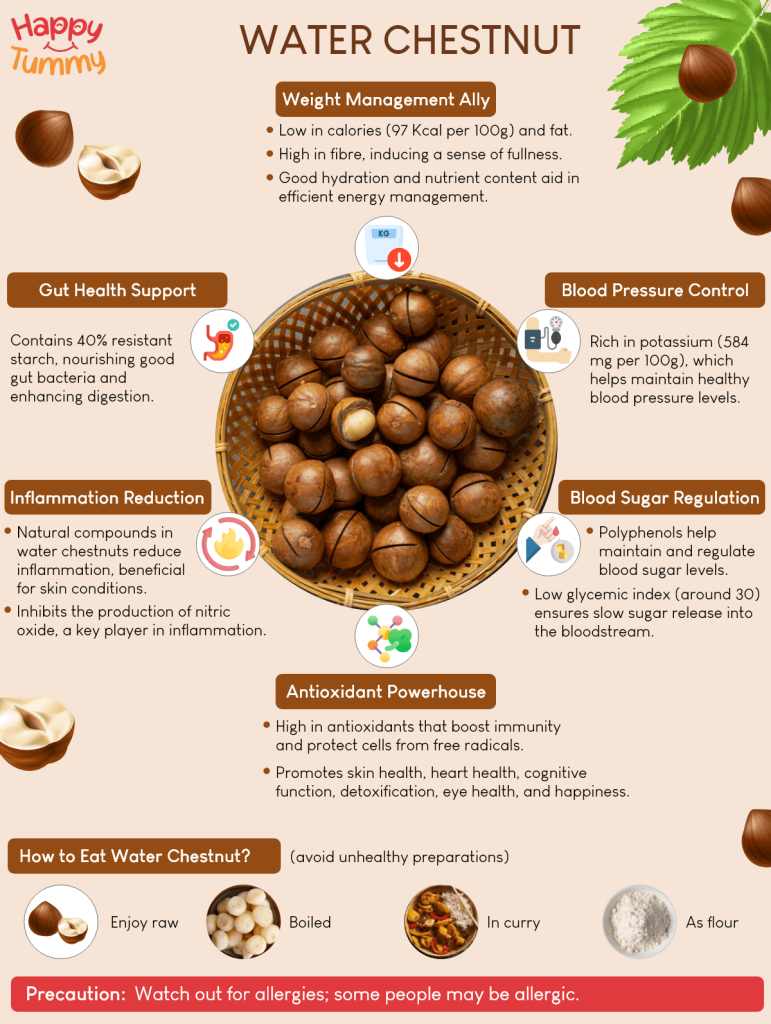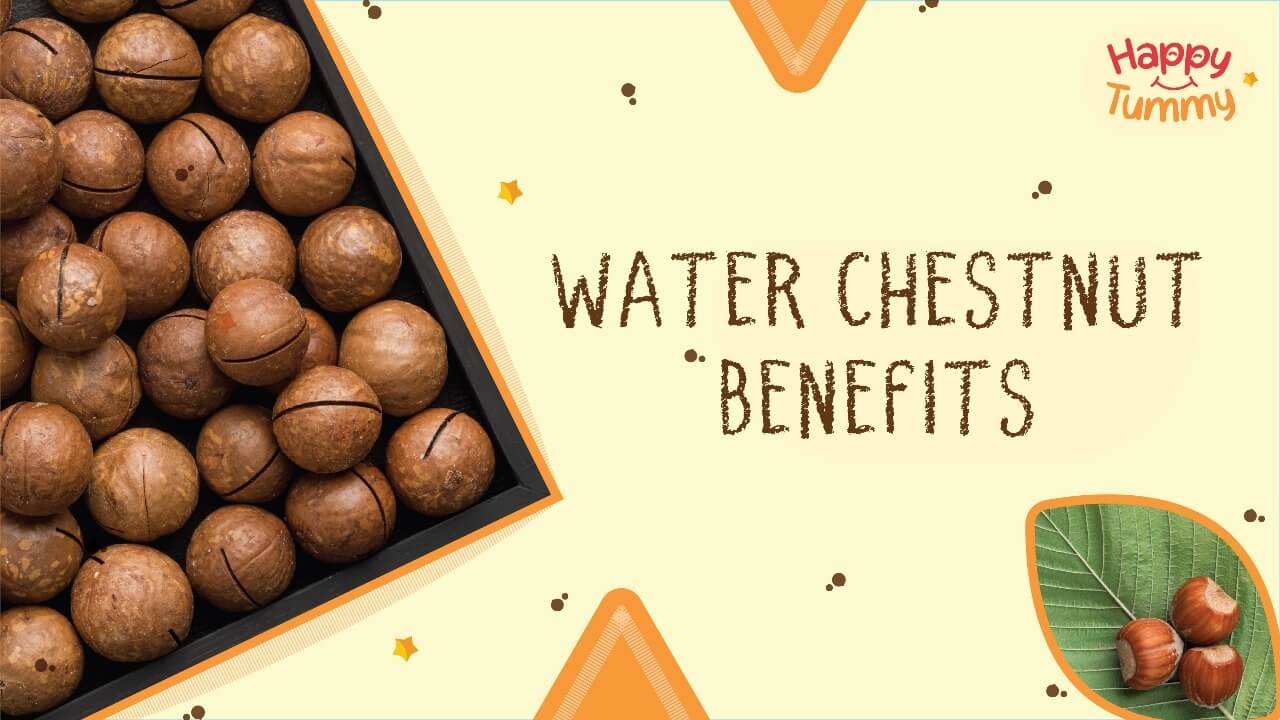Table of Contents
Sometimes, we see fruits that do not look like fruits at all. Neither do they taste sweet and we end up ignoring them.
One such fruit that often suffers our ignorance is the water chestnut.
While for many it appears a neutral-tasting fruit but for me, it always had a special place and the subtle earthy flavour always made me eat another piece. Thankfully, I have seen them grow on the outskirts of town in lakes. Covering the entire lake bed with its green foliage and when uprooted, you get this gem of fruit.
This aquatic gem, sweet swamp swan, which grows beneath tranquil waters, holds brilliant benefits within its chest. And once I tell you those, you’ll definitely want to eat it.
This article will unearth the many benefits of water chestnut and will also reveal what precautions you must take while eating it. Also, you’ll learn a few interesting facts. Let’s dive in.
Know your Water Chestnut – History and Nutrition
The very name of this fruit can deceive you. Contrary to its name, it is no nut at all. Rather, it is a fruit that grows in wild waters. However, many do consider it as an aquatic vegetable too.
It is also called the Chinese Water Chestnut
This fruit is thought to be native to Asia, Africa, and Europe. So, what exactly is it? And why is it called water chestnut?
When we speak of it, we actually speak about a bulb-shaped part that grows under water. We do not eat the plant at all. These bulbs are crunchy and look a bit like a chestnut, though they are not related. The corm is the part of the plant that stores energy and nutrients. And it’s the part that’s harvested and eaten for its nutritional benefits.
So, let’s look at how much nutrition do we get from it.
Water Chestnut Nutritional Value (per 100 grams)[1]
| Nutrients | Amount |
| Calories | 97 Kcal |
| Water | 73.5 grams |
| Carbohydrates | 23.9 grams |
| Fibre | 3 grams |
| Protein | 1.4 grams |
| Fat | 0.1 grams |
| Vitamins | Vitamin C, B, E, K, Folate, Choline, etc. |
| Minerals | Calcium, Magnesium, Phosphorous, Potassium, Selenium, etc. |
| Phytonutrients | Ferulic acid, epicatechin gallate, catechin gallate, etc. |
Especially in Northern India, this fruit is widely cherished in the winter season. There, it is known as ‘Singhara’ in Hindi.
Now, let’s learn how beneficial singhara is for our health.
Water Chestnut Benefits – A Stream of Goodness

Here is a fun thing to start with – Magpie Geese (an Australian bird species), eat these bulbs to put on fat. This allows them to gain fat for the wet season and be ready for breeding.
But don’t worry. You won’t gain fat from eating these brilliant beauties. All you’ll have are the many benefits that we’ll just be looking at.
1. Water Chestnut contains a shield of antioxidants
Let’s start our journey on an alluring note – water chestnuts contain a high amount of antioxidants. These antioxidants become our shield when we face germs and diseases. They strengthen our immunity and protect our cells from the unnecessary damage done by free radicals. [2]
But guarding us from diseases is not the only thing that antioxidants do. They wear many hats and master many tasks. For example:
- Antioxidants grace our skin and wash it with soothing youthfulness. [3]
- Just as we know how important is heart health, so do these wise antioxidants and thus help it. [4]
- These gentlemen also reach our brains and strengthen the very wirings there. In short – they boost our cognitive abilities and preserve memories as we age. [5]
- They also detox our bodies and help us stay sane. [6]
- By protecting our eyes, these visionary molecules preserve the light for our lives. [7]
- Not only this, but they also make us happy. [8]
Brilliant right? Totally! And so, many people suggest its intake during diseases. But the brilliance of these beautiful bulbs goes far beyond their antioxidants.
2. Your watchman in weight management
We all have seen how few calories water chestnut contains. A 100 grams fuels the human body with only 97 calories. This doesn’t stress your system with too much to process. There is no fat or anything that will be hard to digest. All you get are simple carbs, fulsome fibre, and many minerals and vitamins.
So, how does chestnut help in weight management?
- Firstly, it contains few calories;
- Secondly, it contains fibre that induces in us a sense of fullness. When we feel full, we eat less;
- Then it has a high water content. And proper body hydration means better weight
- And lastly, it contains many nutrients that boost immunity and health. Consequently, we get efficient at energy management.
All these things combine and create a cocktail that works in weight management.
Water Chestnut has been traditionally used as an herbal medicine. [9]
3. Feeds good gut bacteria
The digestive force inside your guts, the warriors, are both good and bad. Where the bad bacteria harm us, the good helps us digest food, increase our energy, and arm our bodies with enough strength to knock down the bad guys.
But, these good guys need their food too. And this food comes in the form of fibre. However, not all the fibre we eat reaches these guys undigested and well. But resistant starch makes it to them and water chestnut has around 40% resistant starch content. [10]
This resistant starch strengthens the good gut bacteria and thus enhances digestion. And don’t we all know how easy peasy breezy life feels when guts stay hale and hearty? [11]
4. Balances blood sugar levels
Blood health is vital to our well-being, and so are its sugar levels. Elevated blood sugar levels invite a sea full of issues. Persistent high blood sugar can cause fatigue, frequent urination, excessive thirst, nerve issues, etc. This impacts daily life. And worst of all, high blood sugar levels push our bodies to put on weight.
This means further health issues. Too much negativity. And the potent positivity comes in the form of water chestnuts.
The polyphenols found in them have long been known to help maintain blood sugar levels. Today, studies have also found their impact on glucose levels and how it helps in maintaining it, not just elevated levels but dropped too. But, its regular consumption is needed. [12]
Not just this, singhara also has a low glycaemic index too – around 30. This means that your body releases sugar obtained from it slowly into the bloodstream. [13]
5. A healer and protector of pain
Water chestnuts can also work wonders in reducing inflammation and aiding in the body’s healing processes. Inflammation often shows up as redness, swelling, and pain. But this is a natural response. It indicates your body’s response to tissue damage. However, when it gets prolonged, health gets tossed up high to the sky and beyond.
Water chestnuts contain natural compounds that can help calm down this inflammatory response. [14]
One key player in inflammation is a molecule called nitric oxide (NO). This becomes an annoyance and leads to increased inflammation when overproduced. Now, this fruit has been found to inhibit the production of NO. This means effectively reduced inflammation – very beneficial especially for inflammatory skin conditions.
Apart from that, there are many other ways water chestnut reduces inflammation and protects us from unnecessary pain. For example, they also curb the secretion of pro-inflammatory cytokines like IL-6 and RANTES. These cytokines play a role in chronic inflammatory diseases and lead to a variety of health issues. But let’s not go too much into technicalities.
6. Eases blood pressure
Now, as vital as it is to maintain blood glucose levels, so is to maintain blood pressure. A healthy BP means smooth blood circulation without any drama. This blesses our heart with relaxation and keeps arteries happy – sheer harmony between the heart, blood vessels, and organs.
Singhara, our beloved bulb, contains potassium. That too in good amounts – 584 mg per 100 grams – almost 17% to 20% of our daily requirement. This potassium helps bring our blood pressure to sanity and increase heart health. Another study that proved this had a whopping sample size of 2,47,510 people. [15] [16]
As we see, the benefits that come from it are immense. And we have not even mentioned the many vitamins and minerals that it blesses us with. Getting eager to eat it? Great! But before it, you must know how to eat it and what precautions to take.
How to eat water chestnut?
Water chestnut is a dear part of Chinese cuisine. There, people turn it into flour, make pickles, tin it, turn it into cake, and whatnot. You may choose either of these ways to consume it. However, in India, it is consumed differently. Here are some possible ways to cherish it –
- Eat raw – Simply wash, peel, and eat. That’s it.
- Boil – Another best way is to put them in a pressure cooker with water, and let it whistle a few times. Peel and eat. Add salt for taste.
- Curry – You may even use the boiled part to prepare Indian-styled curry.
- Flour – If you are behind its starch content, dry your nuts and turn them into flour. Use it as a thicker or for any other purpose you want.
The ways could be as many as you know the recipes. Just ensure you do not turn these healthy delights into unhealthy ones.
What about the precautions?
Are there any? Yes! Only one.
When you consume water chestnuts, make sure you do not get any allergies. Some people see an allergic response after eating them. If you notice one, stop there.
Conclusion
From the depths of water to the market, water chestnuts travel a hard path of perseverance. And then they often see our ignorance. But it is time we realize the potential of these potent bulbs and give them their well-deserved space in our lives.
Doesn’t matter if you see it as a fruit or a veggie, what matters is that you eat. It is rich in antioxidants, strengthens our digestive system, balances blood sugar and blood glucose, manages weight, helps with inflammation, and does much known and unknown. Its benefits never cease.
Water chestnut might be a product of swamp, but it surely is a sea full of health benefits. So, embrace it. Soon, you’ll start noticing the changes (given your lifestyle and diet are good). Dive into this crunchy oasis. Stay afloat with its nutrient-rich waves. Because with these nuts, you’re never left high and dry.
To your health and well-being!
FAQs
Singhara can be eaten daily as part of a balanced diet. It is a nutritious and low-calorie food that provides energy, dietary fibre, and essential minerals. However, like any food, it’s best when consumed in moderation.
Along with eating raw singhara, it is also eaten cooked or boiled. Cooking or boiling water chestnuts enhances their flavour, and makes them easier to digest.
Water chestnut is considered a “cooling” food in traditional Chinese and Ayurvedic medicine. It is believed to have a cooling effect on the body.
Water chestnuts (singhara) are relatively low in carbohydrates and have a moderate glycemic index. This means they can be included in a diabetic diet in controlled portions. However, people with diabetes should monitor their blood sugar levels and consult with a healthcare professional to determine the appropriate portion size and frequency of consumption.
















